Visual Afterthoughts… Lydia Maria Child
July 25, 2018

Lydia Maria Child (1802-1880) began her career almost two centuries ago, and some of her writing is dated, yet some resonates today in odd ways. She address the contradiction in American society as to whether to conserve of consume with her association of ideas. Child also offered this thought: The United States is a warning rather than en example to the world.” This odd group including a bird, bees, a squirrel, a whale, a wax doll, and a horse appeared in “Fanny’s Menagerie,” Rainbows for Children (Boston: Ticknor and Fields, 1847): 119-131. Design by Meredith Eliassen, 2018.
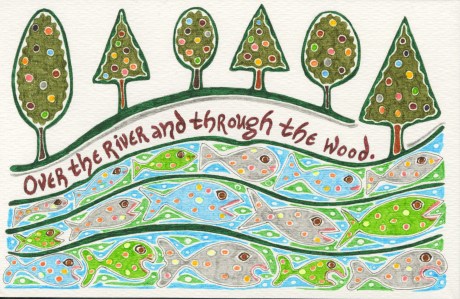
Lydia Maria Child is best remembered for her joyful poem, “The New England Boy’s Song about Thanksgiving Day,” better known as, “Over the River and Through the Woods,” first published in 1844, which conveys human/nature inter-reliance in everyday life. Design by Meredith Eliassen, 2018. Notecard
Lydia Maria Child (1802-1880) began her career during the 1820s, and was well established as a prominent social activist by the 1860s. Her longevity as a writer (55 years) placed her intellectually between the changing democratic antebellum order of the Second Great Awakening and Transcendentalism in post-bellum cultural reforms. Child’s career was well in advance of other activists who sought increased moral political input related to family stability such as the abolition of slavery (1830-1860), child labor reform (1870-1930), child welfare (1890-1930) and women’s suffrage (1900-1920). She was an untiring proponent for the rights of Native Americans and the humane treatment of animals first within the genre of prescriptive literature that shaped women’s everyday lives and then within broader literary genres where a dichotomy emerged between the two didactic genres in relation to a movement to start animal protection societies in the United States.
Adventures of the saucy little squirrel…
April 17, 2018
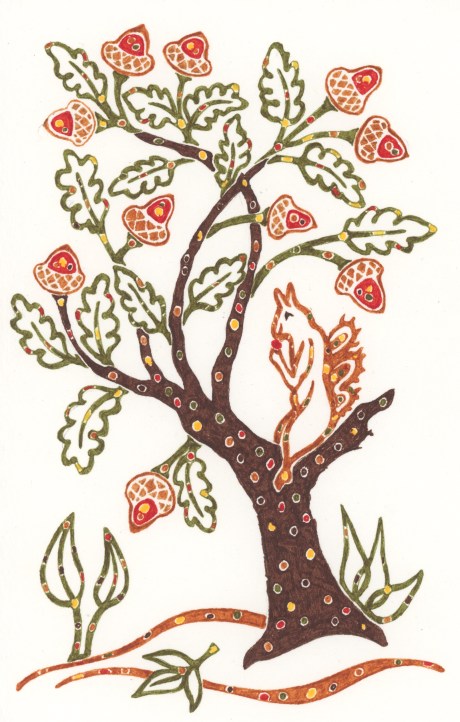
The saucy little squirrel depicted in an early American embroidery design drawn by Meredith Eliassen, 2018.
A gentleman went into the woods to stay all day. He took with him two ears of roasted corn and some bread for dinner. After a while, he sat down under a tree to rest himself, and a little squirrel came capering about. The ears of roasted corn were lying in some clean paper on the ground. I suppose the littler squirrel liked the smell of them. He acted very much as if he wanted to carry them off. He looked at the corn, and then he looked at the gentleman’s face. When he saw him smile, he took hold of one ear of corn with his little sharp teeth, and tried to drag it away; but it was quite too heavy for him. So he nibbled off the kernels, and stuffed his mouth as full as he could. Then he trotted off to his house under the ground and put the corn away for his dinner. He came back again, and stuffed his cheeks as full as they could hold.
He looked up in the gentleman’s face, as if he wanted to ask whether he would whip him from taking his corn. But the gentleman loved the squirrel; and he did not make any noise to frighten him away. So the pretty little creature came to the tree again, and again; and every time he came, he carried off as much as his mouth would hold. He did not leave one single kernel of corn on the ears. I wonder his little feet were not tired, before he got it all stowed away in his house.
I should love to go into the woods, and have a little squirrel come and look up in my face, and carry off my dinner.
Source: Lydia Maria Child. 1844. “The Saucy Little Squirrel,” Flowers for Children II for Children from Four to Six Years Old. New York C.S. Francis & Co., 1855: 18-19.
Learning to treat animals kindly
April 16, 2018
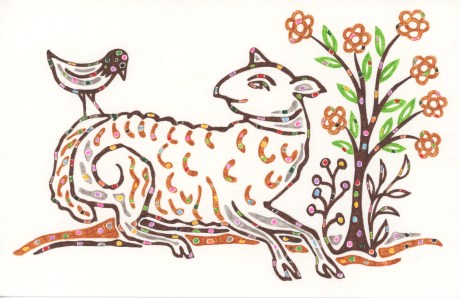
Lucy’s lamb talks to a bird, design by Meredith Eliassen, 2018.
Lucy was a very kind little girl. She never struck the kitten, and when she rode out with her father, she never wanted to whip the horse. When she was eating her bread and milk, a hungry fly would sometimes light on the edge of the owl, and try to drink. Little Lucy never knocked him with her spoon. She would say to him:
“Drink away, poor little fly, You may drink, as well as I.”
One day, when spring weather came, and the sun was warm, and the grass was green, a butterfly flew into the window, and lighted on a beautiful rose that was standing in the sunshine. Lucy jumped up, and clapped here hands, and said, “Oh, what a pretty, pretty, pretty butterfly! Mother, may I touch it?”
Her mother told her she could not touch him, without hurting him. She took down a large dead butterfly, that was pinned over the looking-glass, and told Lucy to put her finger on it. When she took her finger off, It was all covered with fine meal from the butterfly’s wings. Her mother told her that this meal was made of very small feathers, like the down on a bird; but the feathers were so very, very small, that they could not be seen without a magnifying glass.
“Can the butterflies see them?” asked Lucy.
“I suppose they can,” replied her mother; “but I don’t know. I never was a butterfly; and so I cannot tell how much they can see with their little eyes.”
“And when this meal comes off from their pretty wings, does it hurt them?” asked Lucy.
“I suppose it hurts them, as it hurts a bird to pull out its feathers,” said her mother; “and besides than, they cannot fly as well, when the down is taken from their wings. It makes them lame.”
“Then I will never touch a butterfly,” said Lucy.
Lucy’s grandfather lived in New Jersey. He was a good old Quaker gentleman, and Lucy loved him very much. When the snow-ball bush was in blossom, he came to see her, and staid [sic] a whole week. Almost every evening, Lucy too a walk with her good grandfather, and she was a very happy little girl. One evening, they met a man who was driving some sheep and lambs. A chaise-wheel has passed over one of the little lambs, and hurt its leg so badly that it walked very lame indeed. Lucy begged to carry the little lamb home, because it was too lame to trot along after the mother.
“I will buy it for thee, my dear child,” said the old gentleman. “Thou art as gentle as the little lamb thyself. But I think the little one will grieve for its mother; so will buy the old sheep too.”
He bought the sheep, and led her home by a string. Little Lucy carried the lame lamb in her arms. Her mother spread a nice warm blanket in a basket, and Lucy laid the lamb on it, and fed it with warm milk, from her won little china bowl. In a few weeks, it was quite well. One morning, the old gentleman called Lucy to him, and kissed her, and told her he must bid her farewell before she went to school, for he should be gone to Jew Jersey before she cam back. Lucy jumped up in his lap, and hugged him, and kissed him, and said, “Oh, do come back again soon, grandfather. I love dearly to have you come.”
When she put on her cape-bonnet to go to school, she staid [sic] round the good old grandfather, and leaned on his knees, and looked up in his face. “Poor Lucy,” said her mother, “it comes very hard for her to part with grandfather.”
“I must walk to school with the little darling myself,” said the old man. And he took her hand, and she went hopping along, as happy as a kitten.
While Lucy was in school, her father brought the chaise to the door, for the grandfather to ride home. And up trotted the old sheep and the little lamb, as if they had come to say good-bye to their old friend.
“Look at the pretty creatures,” said the old gentleman. The father looked, and smiled when he saw the small bell fastened to a neat little collar round the lamb’s neck. On the bell was written “Little Lucy’s Lamb.”
“Tell my darling, said the grandfather, “that I bought the bell for her, because she is always so kind to every body and every thing.”
When Lucy came home, she was greatly delighted with her lamb’s collar and bell. The little creature became very fond of her and used to follow her all round, like a dog. When the lamb grew to be a sheep, she had many a warm pair of stockings made of her wool.
Source: Lydia Maria Child. 1844. “Little Lucy and her Lamb,” Flowers for Children II for Children from Four to Six Years Old. New York C.S. Francis & Co., 1955: 60-65.
Appearances can be deceiving…
April 13, 2018

Donkey’s nose may seem a little out of joint, but he is a sweet fellow. Collage constructed with Japanese paper by Meredith Eliassen, 2018.
“They say the donkey is a very stupid animal; but he is not stupid. Men beat him, and kick him, and keep him half starved; and that makes him not care about any thing; and so he seems stupid. But he is bright enough, when he is treated, with gentleness and love. It makes all creatures bright and lively, and happy, to be treated kindly. A donkey will do any thing for those he loves; but he does not care to please those who beat him and abuse him.”
Source: Lydia Maria Child. 1844. “Donkey,” Flowers for Children II for Children from Four to Six Years Old. New York C.S. Francis & Co., 1955: 80.
An Awakening (part 1)
April 12, 2018
Before the nineteenth century, scarlet fever was considered to be a benign childhood illness, but between 1824 and 1885 America and England experienced cycles of pandemic scarlet fever, and the United States suffered numerous waves of scarlet fever from 1820 to 1880. First published in Lydia Maria Child’s Juvenile Miscellany in 1829, “Blind Susan, or, The Affectionate Family” told the true story of Susan Mordant who bravely underwent brutal corrective surgery after an illness. Susan appeared to be on the mend, but then died in the story’s conclusion.

“Bah, bah, bah!” The sheep asserted as he wrapped Fanny’s shall around him and took a piece of torn carpet for a cap. Design by Meredith Eliassen, 2018.
In a story called “Fanny’s Menagerie,” edited by Lydia Maria Child (1802-1888) for Rainbows for Children (1847), a young, entitled girl named Fanny has nothing pleasant to do on a rainy, because her wax doll is sick in bed with a scarlet fever. Fanny wishes that she were poor so she could “run about barefoot” in the rain. Frustrated, she throws herself onto her bed and watches the raindrops trickle down the windowpanes with her eyes half shut.
Soon Fanny sees six geese fly into her room. Her first thought is that the geese may have a couple of large quills that she can use for pens. However the geese are angry and they are there for something else. The geese swoop over Fanny’s head and pounced upon her pillow, ripping it to pieces and carrying off as many of the feathers as they can carry and leaving the others scattered around her room.
Fanny next hears a patter, patter, patter at the door and then a big sheep comes in demanding, “Bah, bah, bah! Where is the wool they cut from my back?” The sheep grabs Fanny’s shawl and wraps it around him, the rips her rug to bits and throws a piece over his head. Fanny starts to laugh, but he is not amused and stomps out.
Fanny composes herself as another sound approaches, “Buzz, buzz, buzz!” A swarm of bees appears and the queen bee demands, “Where is our wax?”
“Hum, Hum, Hum! Who stole our wax!” The other bees swarm about the room angrily sticking their stingers into everything until they reach Fanny’s wax doll, then they started nibbling away at the wax on her doll’s face. Fanny gets upset because she loves that doll.
To be continued…
Source: Lydia Maria Child. 1847. “Fanny’s Menagerie,” Rainbows for Children. Boston: Ticknor and Fields: 119-131.
An Awakening (part 2)
April 11, 2018
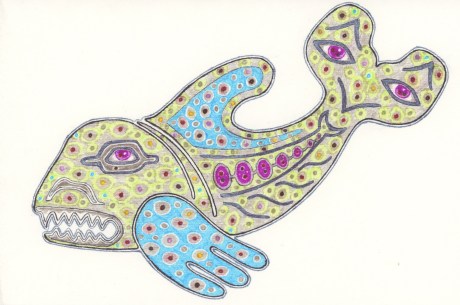
Image of Neptune-Whale was inspired by a nineteenth-century Native American textile design, drawing by Meredith Eliassen, 2018.
Reversing the positions of humans and animals in imaginary depictions was a tactic used to teach children that human and animals suffering was comparable. More than twenty years before the establishment of the San Francisco SPCA in 1868, Lydia Maria Child (1802-1888) selected a story for her Rainbows for Children book that employed rhetoric related to humane treatment of animals in her children’s stories: if you don’t like this treatment yourselves, then don’t do it to us. This logic still can be applied to all minority groups today.
As the story, “Fanny’s Menagerie,” edited by Child, continues, an elephant stomps into the room, shouting, “I want my ivory back! Who carried off my tusks?” The elephant seizes Fanny’s treasured little ivory basket and he quips as he exits with the basket, “It is of no use to me now, but I should like to carry it home to show my little elephants.”
Soon little yellow canary flies into Fanny’s bedroom and she is very sad, the maple tree that has been her home was cut down to make Fanny’s wooden chair. Fanny realizes that she is using products made at the expense of other living creatures and this makes her very sad.
Neptune floats into Fanny’s room on the back of a whale demanding, “Who stole the oil from my favorite whale!” Neptune lifts Fanny’s oil lamp and sails out of the room with it.
Then a fluffy gray squirrel enters, demanding to know, “Who took my nuts?” Fanny feels most awkward since she just took the nuts for her cat to play with, not realizing that they were a food source other animals. When the squirrel realizes that his dinner was a toy for Fanny’s cat, he started pelting her with the stolen nuts.
Poor Fanny wonders what will come next until a great horse enters her room in a fury and rips up her mattress made his hair to shreds before trotting off.
Fanny awakens and realizes that she has only been dreaming. Will she change her ways?
Source: Lydia Maria Child. 1847. “Fanny’s Menagerie,” Rainbows for Children. Boston: Ticknor and Fields: 119-131.
Movements in American reform: Transcendentalism
April 10, 2018
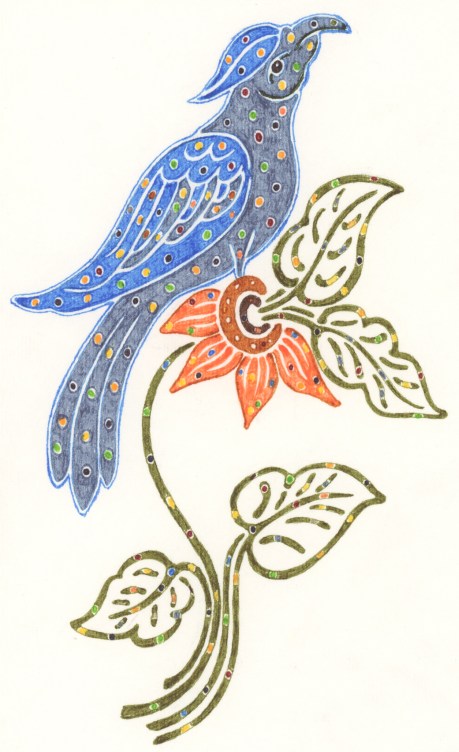
“There are two laws discrete, not reconciled – law for man, and law for thing.” Quote by Ralph Waldo Emerson, bird design by Meredith Eliassen, 2018.
Transcendentalism is, in many respects, was the first notable American intellectual movement; it was a philosophical movement that developed in the late 1820s and 1830s out of a literary circle in Concord, Massachusetts. Inspired by English and German Romanticism and the idealism of Immanuel Kant (1724-1804), it was concerned not with object, but rather with our modes for understanding objects where the human mind became aware of itself.
The transcendentalists longed for a more intense spiritual experience; they believed in the power of the individual and personal freedom. A core belief of transcendentalism is in the inherent goodness of people and nature. Transcendentalism emphasizes subjective intuition of the individual (as opposed to the collective) moral and spiritual sensibilities and the rejection of materialism. Ralph Waldo Emerson wrote in his essay “Self-Reliance” (1841), “Traveling is a fool’s paradise.” Adherents believe that individuals are capable of generating completely original insights with little attention and deference to past masters by turning to nature for spiritual guidance. Writing children’s literature brought Lydia Maria Child a steady income; she also used it to create a consciousness of empathy. Emerson inspired Child in her writing career even as she reacted against the dichotomy in his logic related to men and women’s roles in society.
Lydia Maria Child attended some Emerson lectures during the early 1840s after he set forth the principles of Transcendentalism in his essay called Nature (1936). Emerson delineated two sects of humans by classifying them into materialists (based upon experience) and idealists (based upon consciousness): “The materialist insists on facts, on history, on the force of circumstances and the animal wants of man; the idealist on the power of Thought and of Will, on inspiration, on miracle, on individual culture.” In Lydia Maria Child’s children’s story called “The Magician’s Shadow Box” (1856) the protagonist’s adventure illustrates a transcendental theme where only from such an individual that is at peace with his environment can contribute to the formation of a true community.
There is no place like home…
April 9, 2018
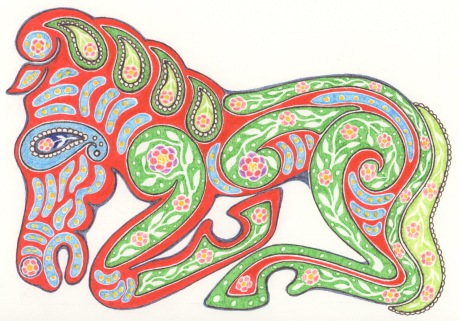
A little red pony from the magician’s shadow box inspired by an ancient carving of a reclining horse found at a burial site at Tuva, Siberia, design by Meredith Eliassen, 2018.
Lydia Maria Child (1802-1888) in her story called, “The Magician’s Shadow Box,” explores human wanderlust with a protagonist named Gaspar. Exposed to progressive international objects and ideas in the small ordinary village where he lives, Gaspar becomes frustrated and runs away into the forest where he is confronted with the natural world. At a first milestone, he throws a stone at a bullfrog that croaks and dives for safety into a nearby pond. At a second milestone, Gaspar unthinkingly throws a pebble at a bird that takes flight, releasing an apple from a tree. Child suggests that Gaspar does not intent to harm these creatures; he has just been thoughtless. At a third milestone, Gaspar meets a mysterious little man cracking chestnuts that for some reason he just cannot pass. Try as he may, the little man will not let Gaspar pass until he has shown him the objects in his little carved shadow box. The little man asserts: “Come now, it is foolish for you to go trudging about all over the world. You will never see anything more than pollywogs and sandflies, and those you can find in your native village…”
Gaspar takes the little man’s chestnuts and returns home. He exchanges them for a horse that he believes will carry him out into a bigger world. However, the horse he receives is mechanical and does not have a soul. Once on the horse, Gaspar finds himself on a journey from which he cannot stop or disembark to explore what his heart truly seeks. Gaspar again returns to his village with a collection of epic imaginings and opens his own curio museum curated with his own creative imaginings. Everyone is very impressed, except for a girl named Hope who has her own take on things. Gaspar takes Hope to meet the little man with the chestnuts, and Hope offers him sprits (wine) for a glimpse at his treasure trove, but she is not impressed. Hope observes: ‘All very pretty, but rather stiff and monotonous… not so good as you can paint, Gaspar. Come, let us go home.”
Source: Lydia Maria Child. (1856). “The Magician’s Shadow Box” The Magician’s Shadow Box and other stories. Boston.
